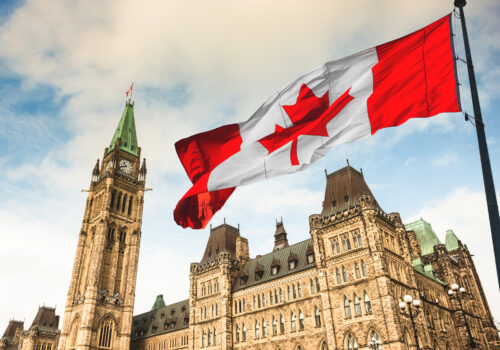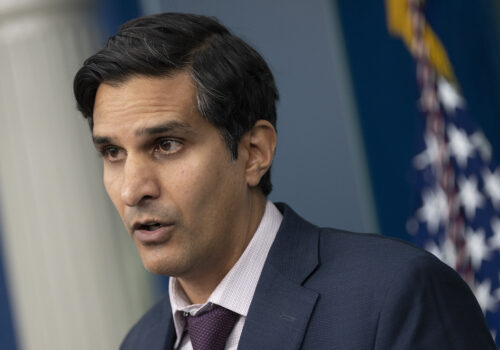Modernizing the tools of economic statecraft to meet the challenges of today
Introduction
Over the last decade, economic statecraft has evolved to become an oft used but ill-defined catchall for the levers of economic and financial policy that advance American national security interests. The implicit assumption often articulated is that US economic and foreign policy strength is best served by unifying “sticks and carrots,” relying not just on the reach of US enforcement but also on the strength of the dollar and the centricity of US financial institutions in the global financial system. While the goals have evolved, the institutions and processes have not kept pace. Stovepiped decision-making within the executive branch and an overreliance on a subset of tools—particularly sanctions—have left the Department of the Treasury, and by default the American financial sector, carrying out only half of the Treasury’s national security mission to combat threats and promote US economic interests at home and abroad.
America’s adversaries are not standing idly by. Their expertise and sophistication are growing at an unparalleled rate, whether through the creation of economies of scale for sanctions evasion; alternative non-US dollar, non-SWIFT settlement systems; or the faster-than-government adoption of emerging technology.
As the current administration revisits the functions and mechanics of government, near-term steps can be taken, under existing statutory authorities, to modernize how the United States uses its economic strength to combat national security threats and promote American interests. This function falls neatly within the Treasury’s remit as the steward of the US economy and financial sector.
Establish an interagency coordination function
As US administrations—regardless of the party in power—are increasingly reluctant (if not opposed) to use military power, economic tools are disproportionately the weapons of choice. Despite the reliance on these levers to address every foreign policy challenge, there is no central coordinating body that is tasked with leading the deployment of these actions or even coordinating tools in the US toolbox. Over successive administrations, this has led to fragmentation and duplication between and within departments and agencies; ineffective assessment of policies, tools, and effects; lack of coordination between punitive and positive measures; overuse of certain tools; and development of nearsighted, short-term policies at the expense of broader strategic goals.
To mitigate these challenges, the Treasury should establish an economic statecraft and security committee, with periodic reports to respective principals, to coordinate interagency work and policies. Representatives from relevant departments and agencies would evaluate policy objectives and identify response options, taking into consideration financial sanctions, regulatory actions, export controls, tariffs, and other “offensive” tools as well as the design and review of development financing, commercial engagement, anti-money laundering/countering the financing of terrorism (AML/CFT) technical assistance programs, and other “carrots” or affirmative tools to establish a clear articulation of goals, end states, objectives, key milestones, and specific outcomes for the aforementioned authorities.
A central coordinating body is desperately needed to effectively deploy all economic tools at the US government’s disposal and ensure that actions are properly sequenced and evaluated. The goal is not to outsource the current role of the National Security Council (NSC); instead, it is to preserve NSC-led strategy and decision-making while injecting a technical coordinating element so the agencies can present a well-crafted and coordinated “menu” of options. The current siloing of tools between the departments of Treasury, State, Commerce, Defense, and others has created a moral hazard for enforcement and undervalues the leverage that the United States maintains with its development and technical assistance programming in supporting national security.
This approach is similar to other models that were created to address gaps in interagency coordination including the Directorate of Strategic Operational Planning within the National Counterterrorism Center, the Committee on Foreign Investment in the United States (CFIUS), and the joint interagency task forces (JIATFs) at combatant commands. This proposed interagency body can be created pursuant to Treasury’s existing authorities and staffed with existing Treasury resources from the Office of Terrorism and Financial Intelligence (TFI), with the addition of staff detailed from other departments and agencies in the form of liaison officers, joint duty assignments, and other such agreements. Departments and agencies represented on the committee should include the Treasury (all components of TFI and International Affairs), the Intelligence Community (IC), the departments of State, Justice, Defense, Commerce, and Energy, the Office of the US Trade Representative, and the International Development Finance Corporation. The Department of the Treasury—and specifically, the policy office of Terrorist Financing and Financial Crimes (TFFC)—is best suited to lead such work, as it closely aligns with its existing statutory mission and the Treasury has an established track record of developing and refining tools to support its AML/CFT mandate, while reconciling humanitarian assistance, derisking, and other unintended consequences. Further, this approach is in line with and implements the authorities provided to the secretary of the Treasury in Section 6104 of the Anti-Money Laundering Act of 2020 within the National Defense Authorization Act of 2021, which directs the secretary to maintain an interagency rotational program to strengthen the United States’ AML/CFT regime and capabilities.
Rejuvenate Treasury’s Office of Intelligence and Analysis
More than two decades after 9/11, Treasury’s Office of Intelligence and Analysis (OIA) confronts several substantive and structural challenges. Sanctions remain the preferred foreign policy tool for policymakers, which has driven US adversaries such as China, Russia, Iran, and others to develop alternative payments systems and mechanisms to circumvent the US dollar-based financial system and “sanctions-proof” their economies. However, across the US government, including at Treasury, there is often a disconnect between economic security and national security that favors generic analysis of disparate topics over complex financial interdependencies. Given TFI’s mandate to protect the US financial sector, OIA should harness its proximity to practitioners and reestablish itself as an economic security analysis unit that provides both a tools-based analysis of national security challenges and studies critical changes to global settlement and efforts to dedollarize the international financial system. To accomplish this efficiently, OIA should detail individuals with macroeconomics expertise from Treasury’s Office of International Affairs, focusing on geoeconomic threats to US interests. It should avoid duplicative tactical functions, such as those of the Office of Global Targeting in the Office of Foreign Assets Control (OFAC) or of the other sixteen IC agencies, while preserving room for strategic network analysis.
Furthermore, the Treasury’s relative lack of internal senior decision-makers (e.g., the secretary, deputy secretary, and three undersecretaries) has incentivized OIA to focus too heavily on external customers and finished intelligence production (e.g., the President’s Daily Brief) that are largely the domain of other, better-resourced IC agencies. This focus has come at the expense of internal Treasury customers, who would be better placed to use and incorporate timely, actionable OIA analysis. OIA’s signature analysis should instead focus on the needs of the Treasury and the deployment of its economic tools including detailed financial analysis, second- and third-order analysis of sanctions and other economic tools, and strategic monitoring and impact assessments. Like the State Department’s Bureau of Intelligence and Research, OIA enjoys regular access to decision-makers—far greater than other members of the IC—working hand in glove with Treasury’s financial attachés, sanctions experts, financial regulators, policymakers, law enforcement, and deployed intelligence and military teams.
OIA should institutionalize more internal mobility across TFI and Treasury writ large to support the mission of economic statecraft-focused analysis. This will increase staff expertise and combat attrition, and is a practical exigency given how many foreign policy issues are simultaneously macroeconomic and illicit finance challenges.
Empower and formalize its attaché program
Treasury’s attaché program, which has existed in some form for decades, places senior Treasury staff in key posts internationally to support development and implementation of US government policy priorities around countering illicit finance and supporting macroeconomic stability. Attachés serve as the Treasury Department’s official representatives to one or more host countries, working directly with foreign finance ministries, central banks, law enforcement authorities, and local financial services firms to inform, develop, and implement economic security policy. The attaché program is an essential but underresourced tool in US economic statecraft.
The current Treasury attaché program is logistically managed by the Department of the Treasury. As of 2025, there are approximately a dozen Treasury attachés serving around the world, although the posts are not static. Unfortunately, attaché positions open and close on a regular basis, often due to changing resources rather than exigent policy needs. For instance, the Treasury has only had a sporadic attaché presence in some posts with major geopolitical significance—including Ankara, Jerusalem, Kiev, and Moscow—largely due to reallocations in department funding and shifting international priorities from one administration to the next. This inconsistency has major implications for the ability to nurture lasting diplomatic ties to host country economic policymakers and to encourage meaningful policy change over the longer term.
Further, internal logistics for the Treasury attaché program are managed on an ad hoc basis, unlike established foreign service officer programs at peer agencies, including the Agriculture, Commerce, and State departments, each of which has a professional foreign service. This creates friction within the embassy system and within the Treasury itself. Because the attaché program is seen as intermittent, the State Department—which is in charge of managing missions and posts overseas—is often reluctant to empower the attaché role, leading to inefficient, long-standing bureaucratic battles between State Department economic officers, who often lack substantive illicit finance and/or macroeconomic analysis expertise, and Treasury attachés. Internally, there is no career service within the Treasury Department for attachés, even though the role is coveted among senior staff. Attachés have limited support at the end of their tours and are often not considered promotion-eligible while serving overseas. Consequently, the Treasury has struggled to retain attachés over time. There are practical ways, however, to enhance the Treasury attaché program and ensure that it effectively supports economic statecraft initiatives.
First and foremost, Congress should formalize the Treasury attaché program by including Treasury as one of the designated foreign service agencies and formally establishing a Treasury diplomatic service corps. The Anti-Money Laundering Act of 2020, which requires Treasury to maintain an attaché program, falls far short in this regard and should be expanded or amended to formally designate Treasury as a foreign service agency. Benefits of congressional recognition of Treasury as a foreign service agency include better integration of Treasury attachés in embassy interagency country teams and clearer lines of reporting directly to either the ambassador or chief of mission rather than to State Department economic officers. A formalized diplomatic program also mitigates the risk of abrupt opening and closing of posts from administration to administration, ensuring greater durability of Treasury attaché posts overseas and less politicization in making location determinations.
Second, the Treasury should establish a lean but dedicated Treasury attaché management office. At present, posts are informally designated as either IA-owned or TFI-owned, yet nearly all posts require substantive expertise and regular engagement with both Treasury components. A management office would reduce the tendency within the Treasury to create silos between IA and TFI and would promote the implementation of a more holistic economic statecraft policy that represents all the department’s interests with foreign partners. A dedicated attaché office would also support returning attachés following their tours, integrate them back in the department, and ensure that the department is able to retain its highest-performing officers.
Introduce technological improvements so that resources are more effective
As America’s adversaries increasingly rely on sophisticated evasion tools and leverage big data and emerging technology to hack, steal, and obfuscate their trail, TFI cannot afford to lean on legacy systems and heavily manual processes to carry out its monitoring, targeting, and enforcement. Doing so only delays timely action, reduces the efficacy of sanctions efforts, and promotes a generally “reactive” stance toward geopolitical change. Against the wider efficiency-enhancing backdrop, modernizing the information technology (IT) infrastructure will position TFI to move at the “speed of business,” allowing the sophisticated and highly technical expertise of TFI staff to be put to higher-order tasks protecting the financial sector and dollar.
At the base of this pyramid is timely and comprehensive analysis of information from a diverse and variable range of qualitative and quantitative data sets, ranging from suspicious activity reports (SARs) and trade data to bulk financial and classified source material. Advancements in IT systems and the targeted deployment of artificial intelligence (AI) will allow TFI’s staff expertise to shift toward evaluating outcomes rather than inputs and will also reduce time spent manually reviewing data sources. A few targeted examples:
- AI and large learning models (LLMs) should be used to help identify trends and indications of high risk among the millions of SARs and other Bank Secrecy Act (BSA) reporting that the Treasury’s Financial Crimes Enforcement Network (FinCEN) receives annually from covered financial institutions. This would allow FinCEN and law enforcement agencies to more easily review and analyze data that the private sector spends billions of dollars to report per year as part of their BSA compliance requirements while hard-coding in rules-based, rather than user-based, privacy controls. This would also support better partnerships with law enforcement and within Treasury and the broader interagency work supporting sanctions targeting, investigations, regulatory policymaking, and enforcement actions.
- OFAC reviews thousands of licensing requests a year relating to the sanctions programs it administers. While each license request relies on a unique set of circumstances, LLMs should be used to enable better triage and processing of licensing requests while steering thin resources toward escalation and review.
- OFAC should leverage AI to compile information needed for sanctions packages that would then be reviewed by sanctions investigators, allowing for faster and more policy-responsive drafting of packages and limiting what is currently a manual process.
- Treasury should develop more robust and autonomous economic modeling, leveraging the expertise of International Affairs and the Office of the Chief Sanctions Economist to increase the diagnostics available to policymakers and evaluate the second-order and economic effects of statecraft tools.
- Treasury should evaluate and streamline internal TFI technology where inefficiencies currently exist; for instance, TFI has multiple duplicative technology networks between FinCEN and the other TFI offices, which complicate information sharing and cyber security while missing opportunities for economies of scale.
- Treasury should evaluate technical improvements to facilitate how the private sector provides BSA reporting and other financial information, including but not limited to SARs, currency transaction reports (CTRs), and CFIUS submissions to streamline processes and reduce costs for both the private and public sectors.
- Treasury should create a TFI chief innovation officer position that reports to the under secretary and works in collaboration with Treasury’s chief technology officer and chief AI officer. The TFI chief innovation officer must be empowered to procure systems and eliminate duplicate resources across components to marshal and use resources well. Without a TFI-specific technology strategy, the organization will fall into the familiar pattern of tinkering with decades-old systems rather than identifying essential upgrades.
The opportunity to modernize US economic statecraft is now
In a March 6 speech at the Economic Club of New York, Secretary Scott Bessent noted that “economic security and national security are inseparable” and that Treasury’s tools and authorities are a critical component of US foreign policy. While Treasury’s tools and authorities remain strong, the ways in which they are used are antiquated. To meet the economic and national security challenges of today, the administration must improve upon the perceived mistakes of its predecessors by leveraging existing authorities and resources to enhance the effectiveness and efficiency of the US economic statecraft tool kit. Facilitating interagency coordination and collaboration on economic statecraft, improving intelligence analysis that informs these economic statecraft policies, enabling the Treasury attaché program, and enhancing Treasury’s capabilities through technology innovations will modernize how the United States wields its economic strength to more effectively protect our economic and national security and the integrity of the US financial system.
Lesley Chavkin is Global Head of Policy at Paxos and a Nonresident Senior Fellow in the Atlantic Council’s GeoEconomics Center. She previously served in a variety of roles at the US Treasury Department, including as Financial Attaché to Qatar and Kuwait.
Eitan Danon is a content marketing manager at Chainalysis. He previously served in several roles at the US Treasury Department and in the US intelligence community. He is also an adjunct senior fellow at the Center for a New American Security and a security fellow at the Truman National Security Project.
Kimberly Donovan is the director of the Economic Statecraft Initiative within the Atlantic Council’s GeoEconomics Center. She previously served in senior roles within the US Intelligence Community, US Treasury Department, and the National Security Council at the White House.
Andrew Gallucci is the Senior Director for Regulatory Strategy at Circle. He previously served in a variety of roles at the US Treasury Department and in the US intelligence community.
Caroline Hill is a Senior Director for Global and Regulatory Strategy at Circle. Caroline’s government time included serving as the Director for Latin America and Africa in the Office of Terrorist Financing and Financial Crimes at the US Treasury Department, as well as Senior Advisor to the Assistant Secretary and Financial Action Task Force President.
Related content
Explore the program

Housed within the GeoEconomics Center, the Economic Statecraft Initiative (ESI) publishes leading-edge research and analysis on sanctions and the use of economic power to achieve foreign policy objectives and protect national security interests.
Image: The United States Treasury Department building in Washington, DC. iStock



